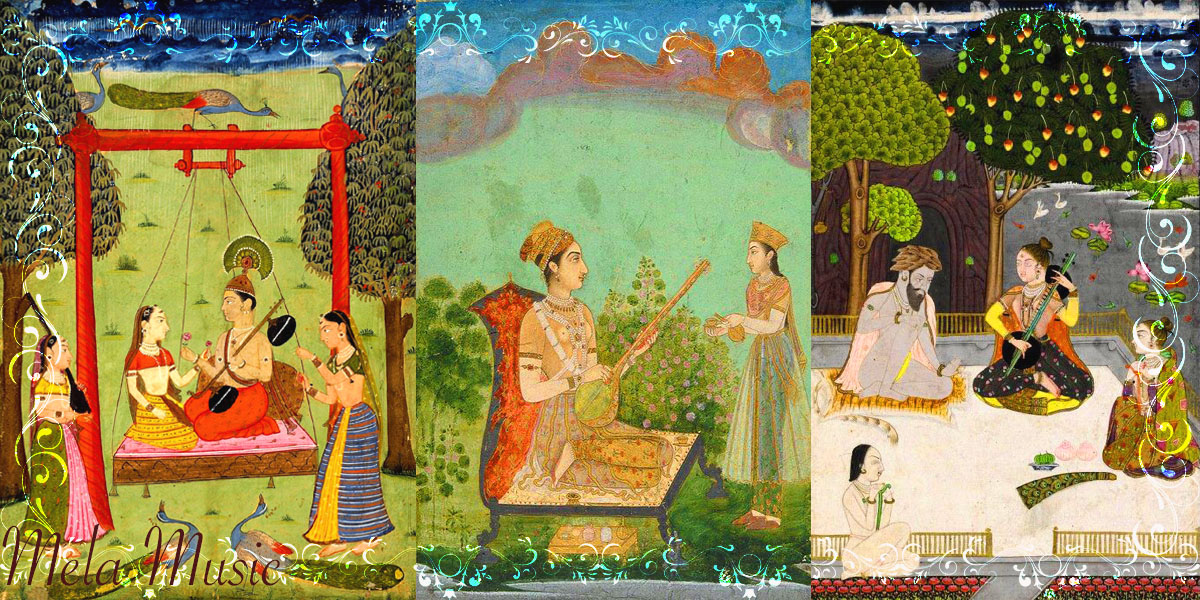
In North Indian Classical music, Vishnu Narayan Bhatkhande categorized ragas into 10 Thaats. Bhatkhande extensively studied various ragas across India and discovered similarities among them. As a result, he devised a system of categorizing ragas based on their characteristics. While many ragas can be classified under these 10 Thaats, it’s important to note that there are also numerous ragas that may not fit neatly into these established categories.
A Thaat represents the natural ascending order of the seven notes in a scale. Within a saptak (seven-note scale), comprising 12 notes including flats, naturals, and sharps, a Thaat utilizes only seven notes. Different combinations of flat, natural, and sharp notes give rise to different Thaats. By selectively omitting one or two notes from a Thaat and arranging the remaining six or five notes in specific ways, various ragas are formed. This distinction between a raga and a Thaat lies in the formation process, as each Thaat can yield multiple ragas.
A Thaat serves as a general classification of notes in their natural sequence, while a raga represents a distinct arrangement of notes belonging to a specific Thaat. The Thaat enumerates the seven shudh (natural or unaltered) or five vikrit (altered-sharp/flat) notes, while a raga enumerates five, six, or seven shudh or vikrit notes based on the specific patterns of aroha (ascending notes) and avaroha (descending notes).
Example: Kafi Thaat – SA RE GA (Komal) MA PA DHA NI (Komal)
Raga: Bhimpalasree
Aroha – NI SA GA (Komal) MA PA NI (Komal) SA
Avaroha – SA NI (Komal) DHA PA MA GA (Komal) RE SA
In the above example, the enumeration of Kafi Thaat is given with the shudh (natural) and vikrit (sharp/flat notes). Also, the aroha and avaroha of Raga Bhimpalasree are shown using the same notes from the Kafi Thaat with its particular ascending and descending sequences of notes.
The rules of Thaat are:
- A Thaat should always be comprised of 7 notes.
- All notes should be arranged in a succession (such as SA RE GA MA PA DHA NI)
- Two forms of a single note are not used one after another. For instance, GA and Komal GA are not used simultaneously.
- A Thaat only has its aroha (ascending notes).
- A Thaat may not be charming because it is not made for performing but to give birth to a raga.
The following is a table of the 10 Thaats and its equivalent western notation.
| Thaat – Asawari | ||||||||
| Indian Notation | SA | RE | GA | MA | PA | DHA | NI | GA, DHA & NI are Komal |
| Western Notation | C | D | E | F | G | A | B | E, A & B are Flat |
| Thaat – Bilawal | ||||||||
| Indian Notation | SA | RE | GA | MA | PA | DHA | NI | All Natural Notes |
| Western Notation | C | D | E | F | G | A | B | All Natural Notes |
| Thaat – Bhairav | ||||||||
| Indian Notation | SA | RE | GA | MA | PA | DHA | NI | RE & DHA are Komal |
| Western Notation | C | D | E | F | G | A | B | D & A are Flat |
| Thaat – Bhairavi | ||||||||
| Indian Notation | SA | RE | GA | MA | PA | DHA | NI | RE, GA, DHA & NI are Komal |
| Western Notation | C | D | E | F | G | A | B | D, E, A & B are Flat |
| Thaat – Kafi | ||||||||
| Indian Notation | SA | RE | GA | MA | PA | DHA | NI | GA & NI are Komal |
| Western Notation | C | D | E | F | G | A | B | E & B are Flat |
| Thaat – Kalyan | ||||||||
| Indian Notation |
SA |
RE |
GA |
| MA |
PA |
DHA |
NI |
MA is Teevra |
| Western Notation | C | D | E | F | G | A | B | F is Sharp |
| Thaat – Khammaj | ||||||||
| Indian Notation | SA | RE | GA | MA | PA | DHA | NI | NI is Komal |
| Western Notation | C | D | E | F | G | A | B | B is Flat |
| Thaat – Marwa | ||||||||
| Indian Notation |
SA |
RE |
GA |
| MA |
PA |
DHA |
NI |
RE is Komal; MA is Teevra |
| Western Notation | C | D | E | F | G | A | B | D is Flat; F is Sharp |
| Thaat – Purvi | ||||||||
| Indian Notation |
SA |
RE |
GA |
| MA |
PA |
DHA |
NI |
RE & DHA are Komal MA is Teevra |
| Western Notation | C | D | E | F | G | A | B |
D & A are Flat F is Sharp |
| Thaat – Todi | ||||||||
| Indian Notation |
SA |
RE |
GA |
| MA |
PA |
DHA |
NI |
RE, GA & DHA are Komal MA is Teevra |
| Western Notation | C | D | E | F | G | A | B |
D, E & A are Flat F is Sharp |
Content Provided By: Sangeetpedia
